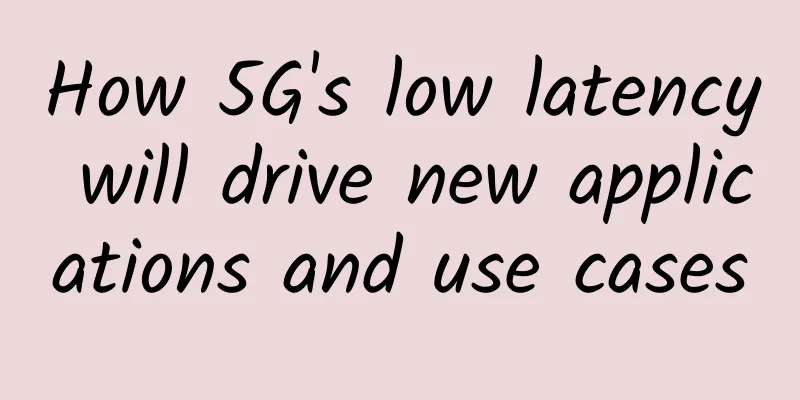How 5G's low latency will drive new applications and use cases

Why is low latency important for 5G?
5G Speed and LatencyUsers' daily smartphone application experience depends on speed rather than latency. 5G's speed and bandwidth far exceed 4G. 5G is expected to provide average data rates of more than 100Mbps, up to 20Gbps during peak hours, and 100 times the network efficiency and traffic capacity. The problem with 5G speed and capacity is that high demand and growth in data traffic on mobile networks has led to network latency. This is not a limitation of 5G, but rather a limitation of the infrastructure behind it, as it relies on cell towers. For example, buildings, trees, and other physical objects can sometimes block signal communications with cell towers. However, 5G can better manage network resources and improve connectivity with multiple cell towers. Today, latency is not an issue for everyday app users, but that may change once AR and VR become mainstream. The biggest issues with latency occur on devices in apps that require real-time communication. 5G challenges and key use cases for low latencyLow latency is crucial for self-driving cars: When data is sent, real-time reactions must be triggered. To avoid accidents, every millisecond counts. Of course, this depends on having sufficient 5G coverage. The potential high cost of failure is the same as for critical emergency services, as lives are at stake. In these cases, low latency is more important than faster data rates. 5G faces challenges: This is not uncommon if we look at previous generations of cellular technology. Issues include public anxiety and the availability of cell towers. It may take years to achieve full coverage. Of course, we can’t forget that the supply chain issues brought on by the global COVID-19 pandemic have also slowed down the growth of 5G. At the same time, it has greatly accelerated the development of new technologies. For example, new services such as self-driving cars rely on low-latency wireless connections with millisecond response times. What changes will 5G's low latency bring?1. New immersive experienceVR and AR enable new ways of working in every vertical, from healthcare to manufacturing. As a result, they create an entirely new experience. 2. New services that change the way we communicateTelemedicine has transformed real-time communication between healthcare professionals and patients. 3. Massive Internet of ThingsThe massive Internet of Things (IoT) involves everyday devices in our lives. It has a large number of sensors and devices that communicate with each other. These devices are usually cheap, consume less energy, and have a wide coverage area. For example, our homes or buildings can have simple on/off options for a range of smart devices. 4. Critical Internet of ThingsCritical IoT involves large-scale scenarios. It has fewer endpoints and can process large amounts of data in more complex situations. An example is traffic safety within a smart city, where failure can lead to widespread complications. Low latency will have a significant impact on all four areas:
As a result, low latency opens the door to a variety of benefits from these new services, including:
5G low-latency real-time applicationsAs 5G availability grows, a lot of things are set to change, from gaming and telemedicine solutions to real-time wireless applications for controlling drones and other robots. Self-driving cars are an example of the importance of 5G's low latency. When it comes to connected driving, data must be transmitted and reactions triggered in real time, as decisions must be made within a fraction of a second. Only then can the car stop or take evasive action before hitting an obstacle. 5G's low latency makes healthcare and telemedicine possibleTelepresence systems have been used by healthcare frontliners during the COVID-19 crisis. Low latency has become more important than ever. First responders must communicate over first responder networks and send vital signs to the emergency room without delay. When latency exceeds approximately six milliseconds, human conversation becomes unnatural and interrupted. Low latency approaching 1 millisecond enables seamless first responder communications. While telemedicine has gained traction due to social distancing and quarantine measures, it is still being used by patients and healthcare providers. For it to be fully effective, doctors must be able to remotely diagnose, treat, and monitor patients in real time. This capability gives patients the best chance for a full recovery. It also provides healthcare professionals with the opportunity to save countless lives. Summarize
|
<<: Eight excellent open source intranet penetration tools
>>: What is optical networking? Full explanation
Recommend
The unwritten rules in data center operation and maintenance
Data centers are important places for information...
How 5G Promotes Smart City Development
Global examples of how smart cities are leveragin...
Huawei releases new 5G products to support Chinese operators in building better 5G networks
[China, March 9, 2020] Today, Huawei held an onli...
Docker novice to practical use: container data volumes, organized clearly
[[419549]] Preface The previous article demonstra...
Yunfan Accelerator's Chen Hui talks about how the revenue of new media in radio and television can outperform the cost
On May 17-18, the 2017 Asia-Pacific OTT/IPTV Ecos...
Sharktech: $99/month-2*E5-2670V2/32GB/500G SSD/1Gbps unlimited traffic/Los Angeles high defense
Sharktech cancelled the lowest-priced $59/month L...
There are many "roadblocks" blocking the way for the full popularization of 5G. When will it be possible?
Now everyone is talking about 5G, just like when ...
Shandong issues six standards for e-government cloud platform construction
Recently, Shandong issued six standards in the fi...
Why are 5G chips so expensive?
Recently, MediaTek officially announced that it w...
Byte side: TCP three-way handshake, very detailed questions!
Hello everyone, I am Xiaolin. A reader was asked ...
China Telecom is working hard to complete the IPv6 network transformation by the end of the year
At the 2018 Global Network Technology Conference,...
Dubbo3.0 Alibaba Large-Scale Practice Analysis—URL Reconstruction
1. Introduction to URL Before we discuss the spec...
Three major trends in digital transformation in 2018, blockchain will usher in spring
In 2017, which is about to pass, digital transfor...
The latest report on the value of the French 5G market: 100% 5G network is expected to be achieved by 2030
According to foreign media reports, in December 2...









